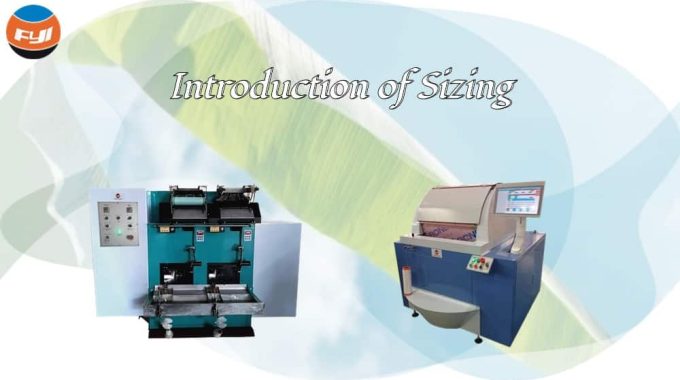
Introduction of Sizing
Sizing is the process of applying size to warp yarns to improve their weavability. Weavability refers to the ability of warp yarns to withstand repeated friction, stretching, bending and other effects of stop sheets, heddles, reeds, etc. on a loom without causing excessive fluffing or even breakage.
Unsized single yarn fibers do not adhere tightly to each other and have more hairiness on the surface, making it difficult to weave. After sizing, part of the sizing liquid penetrates between the fibers, and the other part adheres to the surface of the warp yarn. The sizing that mainly involves the penetration of the slurry into the fibers is called penetrating sizing, and the sizing that mainly relies on the slurry adhering to the surface of the warp yarns is called covering sizing.
Ancient manual sizing involves spreading the warp yarns into sheets, applying paste with a brush or reed, drying and then winding them into weaving beams. Wang Zhen’s “Nongshu” of the Yuan Dynasty contains pictures and texts about using brushes to sizing warp yarns. The “Paste” section of “Tiangong Kaiwu·Naifu Chapter” records the methods and tools for using starch, cowhide, and bone glue silk. At the end of the 18th century, power looms appeared in England, which separated sizing and weaving into independent processes, and the prototype of the modern sizing machine appeared. After several improvements, by 1853 the patent of the British J. Bolov and others had the basic characteristics of a modern sizing machine.
Contents
Sizing method
There are six main methods of sizing warp yarns.
Warp beam sizing
The warp yarns on several warp beams are drawn out at the same time, immersed in the slurry, the remaining liquid is pressed out, dried, divided into yarns, and finally rolled into a weaving beam according to the specified length. This is the most widely used sizing method.
Beam sizing
The weaving beam is made by a slit warping machine and then rolled into a weaving beam after being sized. This method is mostly used in multi-variety and small-batch production of silk and yarn-dyed weaving.
Warp sizing combination
Sizing and drying equipment is installed between the creel and the winding mechanism of the warping machine. Warping and sizing are combined into one process, and are mostly used for sizing chemical fiber filaments.
Dye sizing combination
Install dyeing and drying equipment in front of the sizing tank of the sizing machine, so that the sized yarn is dyed and dried first, and then sizing. The dyeing and sizing are combined into one process. It is mostly used for sizing warp yarns that need to be dyed, such as color warp sizing for weaving labor cloth.
Single yarn sizing
The single yarn is withdrawn from the package, sized by the single yarn sizing machine and then wound into a sized package. The single yarn sizing machine is installed with a sizing tank and drying mechanism on a low-speed winder. Although this method has low output and high labor consumption, the serous film quality is good and is sometimes used in silk and ramie weaving.
Sizing the hank
There are two methods: manual and mechanical. Both of them soak the skein in slurry, wring it, fluff it up, and then dry it. This method is suitable for small batch production of yarn-dyed fabrics and ribbons.
Sizing quality index and its inspection
Sizing rate
The sizing rate is an indicator that reflects the amount of warp sizing. The warp sizing rate is the percentage of the dry weight of the sizing to the dry weight of the original yarn. In production, the methods for measuring warp sizing rate include calculation method and desizing method.
calculation method. Weigh the loom beam (including sizing yarn) and deduct the weight of the empty loom beam itself to obtain the weight of the sizing yarn. Then according to the moisture regain of the sizing yarn measured by the moisture meter, the dry weight G of the sizing yarn can be calculated.
Elongation rate
Sizing elongation rate reflects the stretching of the yarn during the sizing process.
- Calculation method. The calculation method calculates the sizing elongation according to the defined formula based on the length of the warp beam yarn, the length of the weaving beam yarn, the length of the yarn waste and the number of weaving beams.
- Instrumental determination method. The instrument measurement method uses two sensors to measure the yarn length sent from the warping beam and the yarn length transmitted by the head drag roller within a certain period of time, and then calculates the elongation using a defined formula.
Moisture regain
Moisture regain of sized warp is a quality indicator of moisture content of sized yarn, which reflects the degree of drying of sized yarn. The degree of drying is not only related to the energy consumption of the sizing, but also affects the properties of the sizing film (elasticity, softness, strength, re-viscosity, etc.). The moisture regain of sizing yarn is the percentage of the weight of moisture in the sizing yarn to the dry weight of the sizing yarn.
Reinforcement rate and elongation reduction rate
The tensile strength increasing rate and elongation decreasing rate respectively describe the increase in breaking strength and the decrease in breaking elongation of warp yarns after sizing.
Hairiness index and hairiness reduction rate
The degree of hairiness adhesion on the sizing surface is expressed by the sizing hairiness index and hairiness reduction rate. Hairiness index: indicates the cumulative number of hairiness exceeding a certain projected length on a single side of a unit length of yarn.
Factors affecting sizing performance
There are many factors that affect the sizing rate, such as sizing concentration, viscosity, temperature, speed of the sizing machine, pressure of the sizing roller, position of the immersion roller, etc. During the production process, these factors are generally used as detection and control objects, and the purpose of stabilizing the sizing rate of the yarn is achieved by adjusting these factors. At the same time, the sizing rate is related to factors such as fiber material, yarn linear density, fabric structure and density, properties of the sizing used and type of loom.
Sizing speed
The sizing speed determines the liquid film thickness. The influence of sizing speed on sizing rate is determined by two factors. On the one hand, the speed is fast, the pressurizing effect of the slurry roller is reduced, the slurry film is thickened, and the sizing rate is high. On the other hand, the speed is fast, the time for the yarn to pass through the squeeze zone is short, the slurry penetration distance is small, and the penetration amount is small. The comprehensive result of the two factors is that too fast a sizing speed causes the sizing rate to be too high, resulting in surface sizing, while too slow a speed causes the sizing rate to be too low, causing the yarn to be lightly sized and fluffy.
Pressure
Pressure roller pressure, or press force, is composed of the weight of the press roller and the additional pressure generated by the pressurizing device.
When the sizing machine speed, size properties and concentration are constant, the higher the pressure, the smaller the sizing rate; the lower the pressure, the greater the sizing rate.
Slurry concentration, viscosity and temperature
Slurry concentration is the main factor affecting the sizing rate. If other conditions remain unchanged, the larger the slurry concentration, the greater the sizing rate. The slurry viscosity mainly affects the slurry penetration and coating ratio, and also affects the sizing rate. Slurry temperature mainly affects slurry viscosity.
Condition of the press roller surface (elasticity)
When the grouting force is constant, the elasticity is good, the pressure area is large, the pressure is small, and the sizing rate increases; the opposite is true for poor elasticity.
Dip times and immersion roller form
The number of times the yarn is immersed in the size tank, the form of the immersion roller and its height position affect the yarn tension, immersion time and immersion length, and affect the sizing rate and sizing effect.
Yarn tension
The tension condition of the yarn in the sizing tank is required to be at zero elongation or negative elongation to ensure full slurry absorption. When adjusting the sizing rate, if you want to change it in a large range, you must adjust the slurry concentration; if you adjust the sizing rate in a small range, you can change the grouting force.
Yarn Sizing Machine GA392
Yarn sizing machine is suitable for yarn sizing of cotton, flax, silk, wool, chemical fiber, etc. Mechanical part is composed of sizing system, feed system, drying system, yarn storage device, and winding device, etc.



